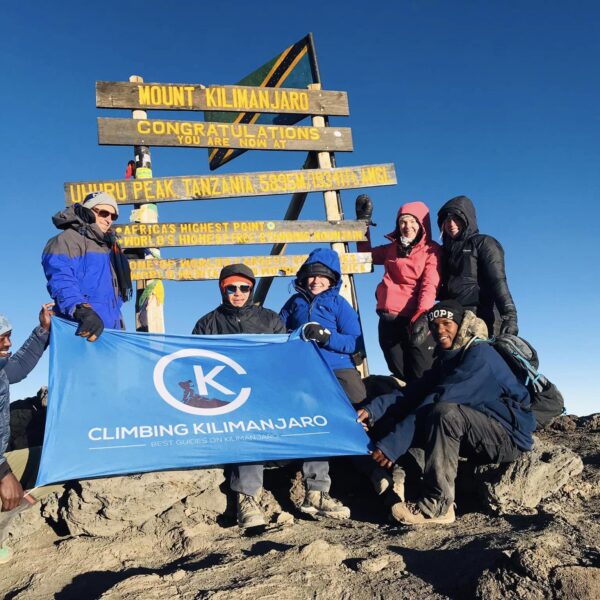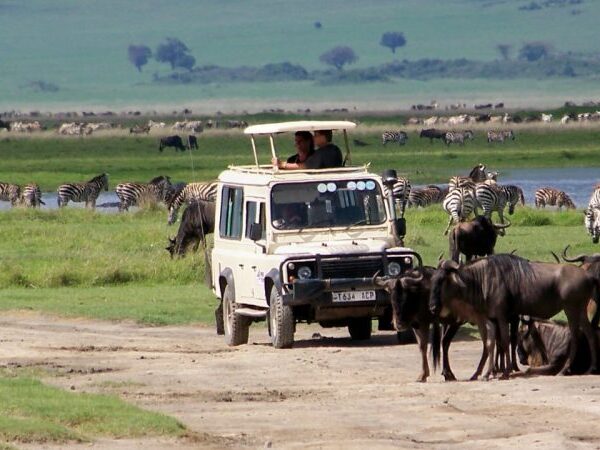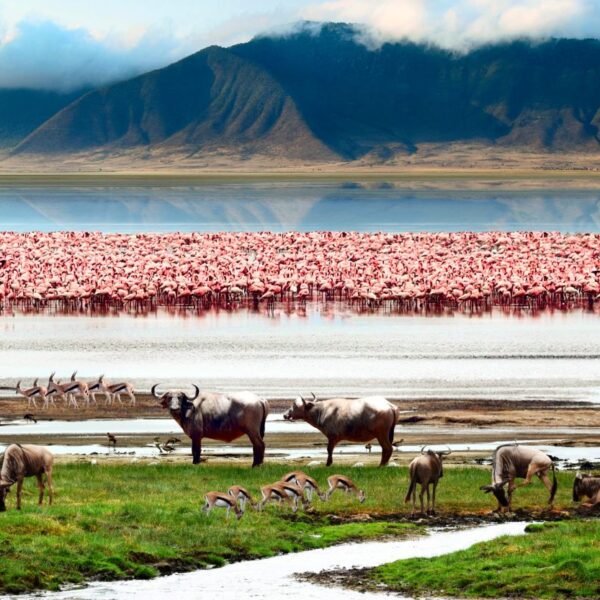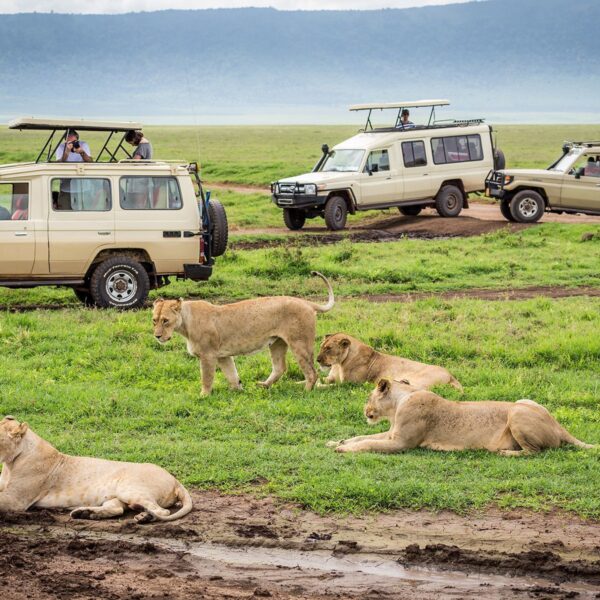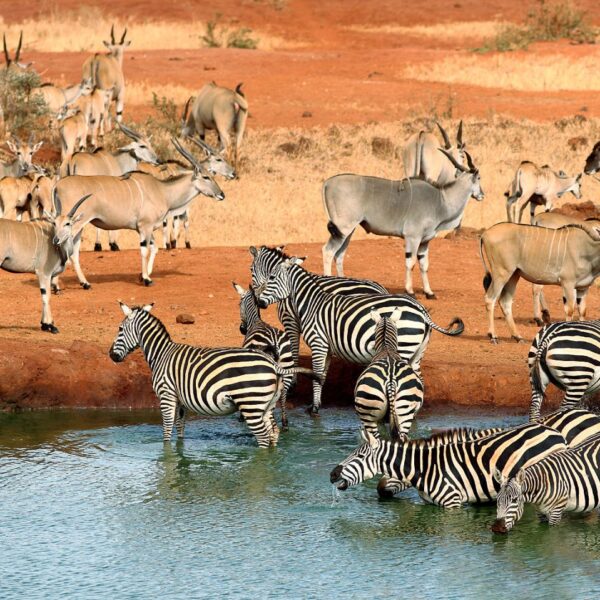Climb Mount Kilimanjaro Lemosho Route From Moshi(7 Days,6 Nights)
Overview
Mount Kilimanjaro is the crown jewel among the Seven Summits that holds a unique allure among adventurers and mountaineers worldwide. It proudly claims the title of the highest peak in Africa and the tallest free-standing mountain globally. It is Africa’s loftiest peak, soaring to 5,895 meters above sea level and its majestic presence beckons those seeking to challenge themselves both physically and mentally.
Located in northeastern Tanzania, near the border with Kenya, it rests approximately 140 kilometers south of Nairobi, the capital of Kenya, and 500 kilometers northeast of Dodoma, the capital of Tanzania. Its proximity to both Kenya and Tanzania makes it a convenient destination for travelers seeking the ultimate high-altitude adventure. If you happen to be a hiking enthusiast, then climbing Mt. Kilimanjaro must be on your bucket list. If you are on the lookout for a professional climbing crew, then book our Kilimanjaro climb via the Lemosho route from Moshi.
Experience the High-Altitude Adventure while Trekking Mount Kilimanjaro
Mount Kilimanjaro is a preferred hiking destination for travel enthusiasts looking for the ultimate high-altitude adventure. This trekking experience is going to offer a diverse range of ecosystems and breathtaking landscapes to explore. From lush rainforests to barren alpine deserts, climbers are treated to a kaleidoscope of natural wonders as they ascend towards the summit. This rich tapestry of biodiversity adds to the mountain’s allure, attracting nature enthusiasts and conservationists alike.
If excited about this trekking then book our Mount Kilimanjaro trekking. We, at Robevin Trekking & Safaris, offer 7 Days and 6 Nights of Mount Kilimanjaro trekking through Lemosho Route from Moshi. Though the mountain has seven routes to reach the summit, Uhuru Peak but one of the best routes to reach the summit is Lemosho Route which ensures a fairly good chance of reaching the “Roof of Africa”.
Conquer Mount Kilimanjaro, the Lemosho Way
Mount Kilimanjaro’s status as the African jewel in the Seven Summits crown is well-deserved, offering adventurers an unparalleled blend of natural beauty, cultural richness, and personal challenge. Standing atop Africa’s highest point is not just a conquest but a triumph over personal limits and obstacles. The Lemosho Route stands out as a premier path for ascending Mount Kilimanjaro.
Renowned for its breathtaking scenery, excellent acclimatization opportunities, and impressive summit success rates, it’s widely regarded as one of the best ways to conquer the peak. Offering unparalleled panoramic views from multiple angles, this route promises a journey filled with awe-inspiring landscapes. With its optimal blend of minimal congestion, stunning vistas, and a high likelihood of reaching the summit, it undoubtedly emerges as the top choice for your Kilimanjaro adventure.
Lemosho Route – Climbers Favored Route
The Lemosho Route spans approximately 70 kilometers or 42 miles, with an elevation gain ranging from roughly 16,000 to 17,000 feet. Widely favored among climbers, this route approaches Mount Kilimanjaro from the west, commencing with a lengthy drive from Moshi to Londorossi Gate. The initial two days are dedicated to traversing the lush rainforest up to Shira Ridge. Subsequently, the trail meanders across the expansive Shira Plateau from west to east, offering a relatively flat and pleasant hike.
Encounter minimal crowds until converging with the Machame route near Lava Tower. Continuing, the path skirts beneath Kilimanjaro’s Southern Ice Field via the Southern Circuit before reaching the summit from Barafu. The descent follows the Mweka route. Optimal for altitude acclimatization, a recommended duration for this ascent is 7 days, boasting an 85% success rate.
Tips to Consider Before Embarking on the Mount Kilimanjaro Hiking
Tourists should understand that preparation is the key to ensuring the success of their Mount Kilimanjaro hiking expedition. The preparation becomes more essential for visitors who have a shorter time frame and eye success in their hiking mission. Travel enthusiasts are recommended to opt for tried and tested personal gear and some of the must-have accessories include:
- Waterproof hiking boots along with several thick socks. Travelers must also make sure that the boots are comfortable to wear and do not cause inconvenient while climbing
- Pack plenty of thermal to combat extreme chillness
- Weather changes quickly and can anytime become extremely cold, so carrying waterproof and windproof pants and shell is vital.
- A big waterproof backpack capable of holding essential items like clothes, food, a camera, and a head torch
- Pack hiking outfits that are comfortable to wear and quick to dry
- Jackets are essential, as these will be required when the temperature drops, especially at the summit where the temperature is -30 degrees Celsius.
- It is vital to pack some essential items like sunglasses, gloves, beanie, and sunscreen
- Carry basic toiletries like toothpaste, toothbrush, and soap
- Hiking snacks like energy bars that have high-calorie options and are lightweight
- A small but handy medical kit to prevent blisters
Hiking Tricks that Prove Handy and Vital
Trekking Kilimanjaro demands ample preparation, a resilient mindset, and collaborative effort. Additionally, certain practices enhance the overall experience. Here are essential tips to optimize your trekking and conquering Africa’s highest peak:
- Prioritize Physical Conditioning – Elevate your workout regimen to build stamina and leg strength essential for Kilimanjaro’s demanding terrain.
- Maintain a Steady Hiking Pace – Begin your climb at a sustainable pace, disregarding the urge to rush. Trek guides typically set a deliberate pace to facilitate gradual acclimatization to increasing altitudes.
- Carry Altitude Sickness Medication – Consult your doctor before departure to discuss altitude-related concerns and obtain suitable medication recommendations.
- Utilize Ski Sticks – Ski sticks prove invaluable during the summit ascent, offering support and easing the strain on knees during descent.
- Preheat Water Bottles at Night – Fill your water bottles with hot water overnight to create makeshift heat pads for added warmth during the journey.
- Pack Favorite Snacks and Hydration Mixes – Include favorite snacks for energy boosts along the trail, and powdered drink mixes like Tang, Gatorade, or Lemonade to maintain hydration levels.
Facilities Offered on Mount Kilimanjaro Climb
In our comprehensive Kilimanjaro climb packages, our goal is to provide an unbeatable blend of affordability and quality for adventurers tackling Kilimanjaro. We believe in delivering top-notch services at competitive prices, ensuring that every step of your journey offers exceptional value. With key essentials like accommodations, experienced guides, meals, ground transportation, and sightseeing all covered in the package, you can plan your adventure with confidence. Moreover, our stellar safety record, unparalleled service, and dedication to responsible travel practices ensure that you get the utmost value for your investment. While facilities on Mount Kilimanjaro may vary depending on the route, you can generally expect basic camping amenities, knowledgeable guides, and reliable porters. Facilities offered include:
- Accommodation – Along the route, accommodation options include two-person tents or huts. The choice between the two depends partly on your preference and partly on availability. Upon arrival, tents are set up for you, but if you have specific preferences for their placement, it’s advisable to take the lead. Huts generally offer warmer shelter than tents, but keep in mind that you may share the space with other trekking parties.
- Water and Washrooms – Water sources are available at various points along the route and should be purified before consumption. Consult your guide for the nearest water points. Washrooms are typically found in the huts but not in the camps. Some camps feature multiple washrooms, so it’s worth scouting for the cleanest option. If nature calls during the trek, aim to find a spot away from the trail and water sources. Remember to bury your waste and paper.
- Mountain Cuisine – Menus for all climbs are carefully crafted to ensure a balanced diet. Expect a variety of fruits, vegetables, proteins, and carbohydrates. Meals are designed to be easily digestible at high altitudes. Dinners usually consist of a main course, accompanied by vegetables and salad. On select days, chicken and fish may also be served. Lunch on the trail typically comprises cold cuts and vegetables laid out for making sandwiches. Fresh hot soup is served after each meal. For breakfast, choose from options like granola, fried eggs, or French toast.
- Trained and Experienced Cooks – Our cooks undergo specialized training and boast extensive culinary experience. We meticulously curate and regularly review our menus to meet dietary needs and preferences. Hygiene in the kitchen is of utmost importance to our cooks. While meals are provided, we recommend carrying your own supply of energy bars for additional sustenance.
Best Time to Plan Mount Kilimanjaro Climb
Historically, the prime seasons for Mount Kilimanjaro climbs span from December to March and June to October. During these periods, temperatures in Moshi, the mountain’s base, hover around 22 degrees Celsius, with summit temperatures dipping to approximately -7 degrees Celsius. It’s generally recommended to steer clear of November and April/May due to the short and long rains. However, it’s worth noting that the shifting seasons have made rain timings less predictable compared to the past. Naturally, as with any mountain excursion, be prepared for rain and snow at higher altitudes regardless of the time of year.
Secure the Expertise of Reputed Robevin Trekking and Safaris for Lifelong Memories
When preparing for your Mount Kilimanjaro adventure, selecting the right travel company is paramount. Among the multitude of tour operators, it’s essential to opt for a reputable and experienced one. Look no further than Robevin, the premier travel company in East Africa. With Robevin Trekking and Safaris, you can embark on your Kilimanjaro climb with confidence. At Robevin, we provide expert guidance, logistical support, and access to top-notch facilities. Some of the reasons to pick our trekking services include:
- Our trekking guides offer comprehensive training and ensure proper acclimatization before your summit attempt.
- Our meticulously crafted itineraries cater to the preferences of most trekkers, ensuring a seamless and enjoyable experience.
- Immerse yourself in local cultures with us, fostering genuine connections and meaningful interactions along the way. Reasons to choose Robevin include:
- Our knowledgeable guides are passionate storytellers, enriching your journey with insights into history, wildlife, and landscapes.
- Experience the convenience of fast online booking, aided by our dedicated team’s passion and expertise.
- With Robevin, prioritize your satisfaction, safety, and the creation of lasting memories that extend far beyond your journey’s end.

